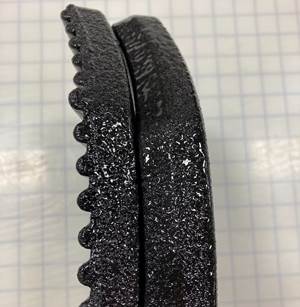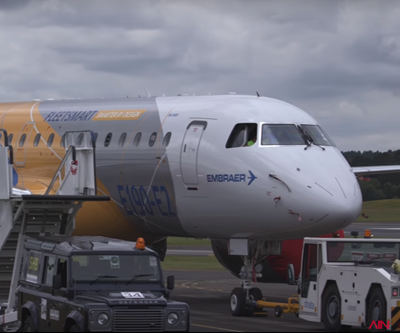Every two years, the Farnborough International Airshow (FIA) brings together global aerospace, aviation and defense professionals to exhibit, demonstrate and announce latest innovations and developments. The show’s platform, divided up into six themes — space, defense, sustainability, innovation, future flight and workforce — provides a comprehensive look at the technologies of tomorrow.
FIA took place this year from July 21-26. With 1,200+ exhibitors and more than 74,000 people in attendance, the international event was a hub of activity. CW compiled an aggregation of some of news announced throughout the show that has relevance to the composites industry below.
See “2022 Farnborough International Air Show highlights” for our last report.
Jekta, ZeroAvia to partner on hydrogen-electric amphibious aircraft
Jekta Switzerland S.A. (Payerne, Switzerland), producing the PHA-ZE 100 composite amphibious aircraft, has selected ZeroAvia’s (Hollister, Calif., U.S.) fuel cell power generation system (PGS) technology to demonstrate the concept of a fuel cell variant of its electric amphibious flying boat design, with a view to line-fit of the system as the PHA-ZE 100 variant comes to market.
Powered by ZeroAvia’s fuel cell PGS, it is anticipated that the PHA-ZE 100 will achieve a range of up to 500 or 600 kilometers and increase the payload by up to 1 tonne, adding more capability to the airframe. Operating and maintenance costs can also be lowered with a hydrogen fuel system supporting a life of up to 20,000 hours. Ultimately, this partnership will give potential operator clients the choice of two fuel sources.
Through close cooperation, Jekta and ZeroAvia will develop and certify an integrated PGS, including inverters, other electronic components, and a hydrogen tank and fuel system. ZeroAvia is already flying a prototype of its entire hydrogen-electric powertrain (ZA600) in a 19-seat testbed aircraft.
Jekta Switzerland also signed an agreement at Farnborough with Seaplane Asia (Hong Kong, China) to add 14 PHA-ZE 100 to the southeast Asian operators fleet. Seaplane Asia will likely optimize the Jekta airframes for fulfilling short-distance flights, island hopping, transport from airports to waterfront locations, sightseeing flights and yacht transfers.
KLM, ZeroAvia plan zero-emission demonstration flight using liquid hydrogen
ZeroAvia and KLM Royal Dutch Airlines (The Hague, Netherlands) are working toward a demonstration flight using ZeroAvia’s ZA2000 zero-emission, hydrogen-electric engines for large regional turboprop (read “ZeroAvia advances to certify ZA600 in 2025, launch ZA2000 with liquid hydrogen in 2027”).
As a first major target milestone, the companies aim to conduct an initial A-to-B flight demonstration between two airport locations in 2026. As well as identifying the optimal airport pair, immediate workstreams will be working toward regulatory permits to fly and ensuring supply of liquid hydrogen fuel and putting in place the supporting infrastructure for aircraft fueling.
Ecojet (Edinburgh, Scotland), an electric, commercial airline, has signed an agreement to purchase 22 ZA2000 hydrogen-electric engines from ZeroAvia. Ecojet’s aim is to build a fleet of larger regional aircraft to serve passengers on key domestic and shorter international routes.
Eve Air Mobility reveals first full-scale eVTOL prototype
Eve Air Mobility (São José dos Campos, Brazil) has rolled out its first full-scale eVTOL prototype being built at the Embraer test facility in Gaviao Peixoto, Sao Paulo State. The company has also announced that it has completed the selection of the aircraft’s primary suppliers, many of which have already been previously reported on by CW.
Source | Eve Air Mobility
This activity will be followed up by preparation of a rigorous testing campaign. Prior testing of the prototype have target a meticulous assessment of every aspect of the aircraft’s operation and performance, from flight capabilities to safety features. These insights will play an important role in refining the design and functionality of the aircraft. “This extensive testing phase begins the next fundamental step in our journey,” said Johann Bordais, CEO of Eve Air Mobility. “It ensures that our eVTOL meets the high standards and expectations we’ve set for performance and safety.”
Lilium reaffirms 2026 target for first customer deliveries, provides testing program updates
Lilium (Munich, Germany) has confirmed its delivery schedule, enabling first customer deliveries in 2026, and provided additional program details. This confirmation is based on a recent program review that considered the testing and validation requirements needed prior to first manned flight, which is now scheduled for early 2025, and the readiness of its support organization and training devices for its customers.
Lilium is currently building the first two aircraft at its production facility in Gauting, south of Munich, Germany. The company has been working with FlightSafety International on an engineering simulator which will be delivered early next year. The simulator will be used to support the type certification program.
Lilium Jet MSN 2, now scheduled to perform the first manned flight in early 2025, is being assembled with its fuselage, landing gear, wing, canard and electric harnesses. This change, driven by the delivery of certain parts of flight-testing equipment, component parts of the aircraft, and software, is due to the indirect effects of the ongoing industry-wide supply chain constraints. This shift has no material impact on customer deliveries, program planning or total program costs. Assembly of MSN 3 will start later this year, and the aircraft will join the certification flight test campaign in 2025.
Lilium and FlightSafety International will soon present a flight crew training simulator to EASA and FOCA (the Swiss Federal Office of Civil Aviation which supports EASA in the training program certification). This will pave the way to final development of the training devices.
On top of its certification effort, Lilium continues to build its support and services organization, Lilium Power-On, to ensure a smooth entry into service experience for its customers.
Klaus Roewe, CEO of Lilium, anticipates an announcement by year end for the 2026 launch location of the Lilium Jet with one of its customers.
GE Aerospace grows MRO capacity
Aviation Week’s Alex Derber announced that GE Aerospace (Cincinnati, Ohio, U.S.) has plans to invest $1 billion over 5 years in its global maintenance, repair and overhaul (MRO) facilities across the Americas, Europe and Asia. This will support wide- and narrowbody engines, as well as GE’s CFM LEAP engine line — 3,300 are currently in service, and 10,000 engines are on order.
LEAP engines make extensive use of composites — read “LEAP backlog spurs composites production expansion” and “Plant tour: Albany Engineered Composites” for more info.
Airbus announces customer purchases at Farnborough
Airbus (Toulouse, France) has released numerous announcements concerning customer aircraft purchases, which are as follows:
- Berniq Airways: 6 A320neos
- Drukair - Royal Bhutan Airlines: 3 A320neos and 2 A321XLRs
- VietJet Air: 20 A330neos
- Flynas: 75 A320neos and 15 A330neos
- Japan Airlines (JAL): 20 A350-900 widebodies, 11 single-aisle A321neos
- Virgin Atlantic: 7 A330neo aircraft, with purchase rights for 9 more.
- Abra Group: 5 A350-900s
Boom Supersonic accelerates Overture aircraft, engine development
Boom Supersonic (Denver, Colo., U.S.) has reported milestones across its Overture airliner and Symphony engine programs. Boom is reinventing the cockpit with an all-new flight deck, designed around pilots with safety at the forefront. The company says it is making rapid progress on its Symphony engine, with hardware testing underway and the first full-scale engine core to be operational in just 18 months. Additionally, Boom announced that Symphony will be assembled in San Antonio, Texas, through an expanded agreement with StandardAero.
Honeywell, Electra join up for key flight technology on composite hybrid-electric aircraft
Electra.aero Inc. (Electra, Manassas, Va., U.S.) has selected Honeywell (Charlotte, N.C., U.S.) flight control computers and electromechanical actuation systems for its nine-passenger hybrid-electric short takeoff and landing (eSTOL) composite aircraft. These critical technologies will support the fixed-wing eSTOL aircraft’s ability to fly safely and efficiently, helping advance the future of more sustainable and affordable regional air travel. Additionally, Honeywell has made a strategic financial investment in Electra.
Customer commitments for Boeing aircraft purchases
Boeing (Arlington, Va., U.S.) has firmed up several customer purchase agreements as follows:
- Qatar Airways: 20 777-9s
- Macquarie AirFinance: 20 737-8s
- Japan Airlines (JAL): 20 787 Dreamliners (10 787-9s with options for 10 more)
- Korean Air: 50 widebodies — 20 777-9s and 20 787-10s, with options for 10 more of the largest 787 Dreamliner variant.
- National Airlines announced: 4 777 Freighters.
Airbus RACER reaches cruise speed target in just seven flights
Airbus’ RACER high-speed helicopter demonstrator, developed under the European Research Clean Sky 2 project, less than two months after its first flight, exceeded its level speed objective of kilometers/hour (km/h), or 220 knots (kts) by reaching 420 km/h (227 kts) in its initial configuration. In just seven flights and about 9 hours of flight testing, almost all of the flight envelope has been opened.
The next phase of flight testing will focus on single-engine operations and finalize the flight envelope. The RACER is optimized for a cruise speed of more than 400 km/h, while targeting a fuel consumption reduction of around 20%. The RACER also aims to demonstrate how its particular architecture can contribute to lowering its operational acoustic footprint.
Read “Optimizing AFP for complex-cored CFRP fuselage” and watch the demonstrator’s flight, “Airbus video highlights RACER compound helicopter first flight.”
GKN delivers composite wing and booms for Supernal’s eVTOL
GKN Aerospace (Redditch, U.K.) has successfully delivered the full composite wing assembly, and by end of July will deliver booms, for Supernal’s (Washington, D.C., U.S.) first electric vertical takeoff and landing (eVTOL) demonstrator aircraft. The Full-scale Technology Demonstrator (FSTD) will begin flying later this year. Supernal’s eVTOL vehicle is targeted to enter into commercial service in 2028.
Read CW’s full announcement here.
Bell expected to look for a new future long-range assault aircraft fuselage (FLRAA) supplier
Bell Textron Inc. (Fort Worth, Texas, U.S.) is said to be looking for a replacement for Spirit AeroSystems’ (Wichita, Kan., U.S.) fuselage work for its V-280 aircraft program once the aerospace company is reacquired by Boeing, reports Aviation Week.
It will be a major shift for the military rotorcraft — which will include at least 400-500 aircraft for the army before international sales. Each fuselage is a 47-foot-long structure comprised of aluminum sub-structure with composite skins.
Sen. Jerry Moran (R-Kan.) told Aviation Week, “I want to make certain that that work continues in Kansas, but I particularly want to make certain that we do not do anything in this acquisition that diminishes the capability of meeting our defense needs nationwide, or globally, by any kind of pause, any kind of disruption in the supply chain.”
Eve Air Mobility unveils first full-scale eVTOL prototype
Eve Air Mobility (São José dos Campos, Brazil) has announced a significant advancement in the assembly of its first full-scale eVTOL prototype. During Farnborough, the company unveiled the aircraft being built in the Embraer test facility of Gaviao Peixoto, Sao Paulo State.
In addition to the roll-out of its prototype, Eve has also announced that it has completed the selection of the primary suppliers for its eVTOL aircraft. As Eve advances into the next phase of development, the eVTOL prototype already has a series of comprehensive testing campaigns. These campaigns are designed to meticulously assess every aspect of the aircraft’s operation and performance, from flight capabilities to safety features. These valuable insights will play an important role in refining the design and functionality of the aircraft. “This extensive testing phase begins the next fundamental step in our journey,” says Johann Bordais, CEO of Eve Air Mobility. “It ensures that our eVTOL meets the high standards and expectations we’ve set for performance and safety.”
MOU agreements expand VoltAero Cassio hybrid-electric aircraft capabilities, market scope.
VoltAero (Médis, France) has made a couple of annoucements this week. The company signed a memorandum of understanding with Global Sky (Tokyo, Japan), a company that provides aircraft trading services to aircraft owners, for the pre-order of 15 Cassio aircraft, becoming a candidate launch customer in Southeast Asia for VoltAero’s family of hybrid-electric airplanes.
In addition, VoltAero is working with Sigma Air Mobility to explore the development of Cassio’s advanced air mobility solutions, opening the potential for a route demonstration pilot project, along with the identification of services for Cassio in its air ambulance version.
The pilot project envisioned in the agreement will showcase the Cassio’s capabilities in operational conditions, while also fostering local network growth and defining use cases. Its location will be announced later this year.
Also identified in the MOU is the joint opportunity to develop industry technical standards for airport recharging infrastructures, facilities and the related technologies; along with the potential collaboration on operating models, economics and decarbonization trends and metrics to further adjust growth plans.
VoltAero’s Cassio electric-hybrid aircraft family will be a highly capable and reliable product line for regional commercial operators, air taxi/charter companies, private owners, as well as in utility-category service for cargo, postal delivery and medical evacuation (Medevac) applications. It will be produced in three versions: the five-seat Cassio 330; the Cassio 480 with six seats; and the 10-12-seat Cassio 600.
Learn more about Cassio.










































